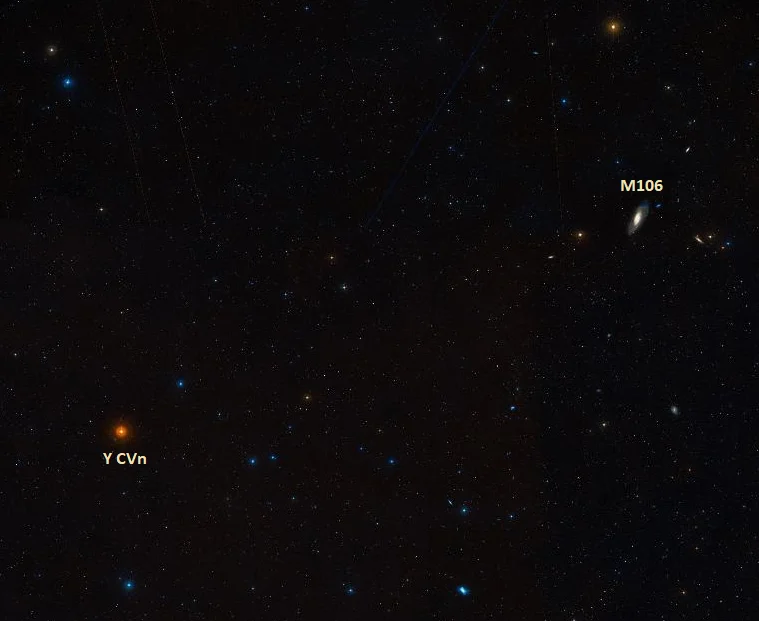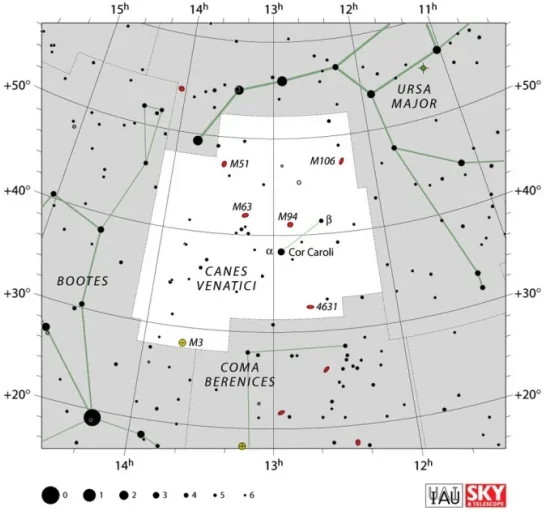La Superba, Y Canum Venaticorum (Y CVn) is a red giant star located in the constellation Canes Venatici. Classified as a carbon star and a semiregular variable, the star is notable for its striking red colour. It is one of the reddest stars known, as well as one of the brightest giant red carbon stars in the sky. With an apparent magnitude that varies from 4.86 to 7.32, La Superba is relatively faint and often invisible to the unaided eye. It lies at a distance of 760 light years from Earth.
Star type
La Superba is a red giant with the stellar classification C54J(N3). It is one of the brightest giant carbon stars and one of the reddest stars known. It is slightly redder than Mu Cephei (Herschel’s Garnet Star) and 119 Tauri (Ruby Star), but not quite as red as T Lyrae, R Leporis (Hind’s Crimson Star), and V Aquilae.
La Superba has a mass of 1.6 solar masses and has expanded to a size of 352 solar radii. Its initial mass was probably around 3 solar masses, but the star has lost a lot of it through a strong stellar wind. It is believed to shed mass at the rate of about a million times that of the Sun.

La Superba (Y Canum Venaticorum), image: Wikisky
With a surface temperature of about 2,760 K, La Superba is one of the coolest stars known. It is 6,200 times more luminous than the Sun. A good portion of its output is in the invisible infrared part of the spectrum.
The brightness of Y CVn varies from magnitude 4.86 to 7.32 over a period of about 160 days. Other periods – of 186, 194 and 2,000 days have also been suggested.
La Superba is currently on the asymptotic giant branch. This is a late evolutionary stage in the life of low- to intermediate mass stars during which the stars grow to giant proportions and their luminosity increases to up to thousands of times that of the Sun. Like all AGB stars, La Superba has a mostly inert carbon-oxygen core. It is fusing helium to carbon in an inner shell around the core and hydrogen to helium in an outer shell. The products of fusion are transported outwards by convection (mass movement of plasma), creating an abundance of carbon in the outer atmosphere.
La Superba is now in the final stages of its life cycle, with only thousands of years left before it reaches the end. As it is not massive enough to go out as a supernova, it will eventually expel its outer layers to form a planetary nebula and meet its end as a faint white dwarf.
La Superba is one of the very few carbon stars visible without binoculars. Carbon stars are typically evolved luminous red giants on the asymptotic giant branch with more carbon than oxygen in their atmospheres. The carbon-rich atmospheres give them a strikingly red appearance. These stars were first recognized by the Italian astronomer Angelo Secchi in the 1860s.
Facts
In 1993, observations of 512 red giants with the Infrared Astronomical Satellite (IRAS) revealed that La Superba was surrounded by a dust shell of ejected material that extends 0.9 parsecs (2.9 light years) in diameter and has an inner radius of 0.23 parsecs (75 light years). The appearance of the shell indicates that, at some point, the star was losing mass about 50 times faster than it is now.
La Superba is one of the brightest carbon stars in the sky, along with TX Piscium (mag. 4.79 – 5.20) in the constellation Pisces and U Hydrae (mag. 4.89) in Hydra.
La Superba is the brightest known J-star, a non-classical carbon star with strong absorption bands of carbon-12 (13C).
The star’s angular diameter was measured at 13.81 ± 0.43 milliarcseconds using the Mark III Stellar Interferometer at the Mount Wilson Observatory in 1994. At a distance of 760 light years, this corresponds to a physical radius of 1.50 astronomical units (Earth-Sun distances). If it replaced the Sun in our solar system, La Superba would extend past the orbit of Mars.
Name
Y Canum Venaticorum was named La Superba by the 19th century Italian astronomer and spectroscopy pioneer Angelo Secchi, who was the first to develop a stellar classification system (the Secchi classes). In his 1868 catalogue, Secchi described the star as a “splendid object of type IV which is truly outstanding for its vividness.”
The name La Superba was approved by the International Astronomical Union’s (IAU) Working Group on Star Names (WGSN) on August 10, 2018.
Location
La Superba is relatively easy to find because it lies near the Big Dipper, one of the most recognizable asterisms in the sky. The two brightest stars in Canes Venatici – Cor Caroli and Chara – are easy to identify on a dark, clear night because they lie almost directly below Alkaid and Mizar, the stars at the end of the Big Dipper’s handle (or the Great Bear’s tail).

La Superba location, image: Wikisky
La Superba lies just west of the imaginary line connecting Mizar and Chara. Alternatively (because Chara is challenging to see from light-polluted areas), Y CVn can be found about a third of the way from Cor Caroli to Megrez. The bright spiral galaxy Messier 106 lies in the same area of the sky. La Superba is noticeably redder than other stars in the vicinity, but since it is often too faint to be visible to the unaided eye, binoculars may be required to see it.

La Superba and Messier 106, image: Wikisky
Constellation
La Superba is located in the constellation Canes Venatici. Representing the hunting dogs of Boötes, the Herdsman, the constellation lies between the larger Boötes and Ursa Major. Even though it is associated with Boötes in mythology, it is not one of the 48 Greek constellations. Canes Venatici was created by the Polish astronomer Johannes Hevelius from the faint stars under the tail of Ursa Major in the 17th century. The constellation’s brightest star, Cor Caroli, lies directly below Alkaid, the star at the tip of the Great Bear’s tail.

Canes Venatici constellation map by IAU and Sky&Telescope magazine
Canes Venatici is not particularly large. It is the 38th constellation in size, stretching across an area of 465 square degrees.
The constellation is best known for the sunlike star Chara and the variable stars La Superba, Cor Caroli, the prototype for its own class (Alpha2 Canum Venaticorum variables), the cataclysmic variable AM Canum Venaticorum, and the close binary system RS Canum Venaticorum.
Canes Venatici also hosts several well-known deep sky objects. These include the Whirlpool Galaxy (Messier 51), the Sunflower Galaxy (Messier 63), the spiral galaxy Messier 94, the Whale Galaxy (NGC 4631), the Hockey Stick Galaxy (NGC 4656 and NGC 4657), the Heron Galaxy (NGC 5394 and NGC 5395), the Cocoon Galaxy (NGC 4490), and the bright globular cluster Messier 3.
The best time of year to see the stars and deep sky objects in Canes Venatici is during the month of May. The entire constellation is visible from locations between the latitudes 90° N and 40° S.
The 10 brightest stars in Canes Venatici are Cor Caroli (Alpha CVn, mag. 2.81), Chara (Beta CVn, mag. 4.26), 24 Canum Venaticorum (mag. 4.68), 20 Canum Venaticorum (mag. 4.715), AW Canum Venaticorum (mag. 4.73 – 4.85), 5 Canum Venaticorum (4.767), 25 Canum Venaticorum (mag. 4.82), BH Canum Venaticorum (mag. 4.91), HD 115004 (mag. 4.94), and 6 Canum Venaticorum (mag. 5.01).
La Superba – Y Canum Venaticorum
| Spectral class | C54J(N3) |
| Variable type | SRb |
| U-B colour index | 6.62 |
| B-V colour index | 2.54 |
| V-R colour index | 1.75 |
| R-I colour index | 1.38 |
| Apparent magnitude | 4.86 – 7.32 |
| Absolute magnitude | -1.203 |
| Distance | 760 ± 40 light years (230 ± 10 parsecs) |
| Parallax | 4.3115 ± 0.2425 mas |
| Radial velocity | 15.30 ± 0.4 km/s |
| Proper motion | RA: -2.675 ± 0.239 mas/yr |
| Dec.: 14.783 ± 0.279 mas/yr | |
| Mass | 1.6 M☉ |
| Luminosity | 6,200 L☉ |
| Radius | 352 R☉ |
| Temperature | 2,760 K (2,600 – 3,200 K) |
| Surface gravity | -0.121 cgs |
| Constellation | Canes Venatici |
| Right ascension | 12h 45m 07.8257032577s |
| Declination | +45° 26′ 24.898861195” |
| Names and designations | La Superba, Y Canum Venaticorum, Y CVn, HD 110914, HR 4846, HIP 62223, SAO 44317, FK5 1327, BD+46°1817, GC 17342, GCRV 7648, PPM 53169, AG+45 1021, JP11 2289, PLX 2936.00, AAVSO 1240+45, IRAS 12427+4542, 2MASS J12450780+4526249, UBV 21484, TYC 3459-2147-1, Gaia DR2 1542553623370677504 |